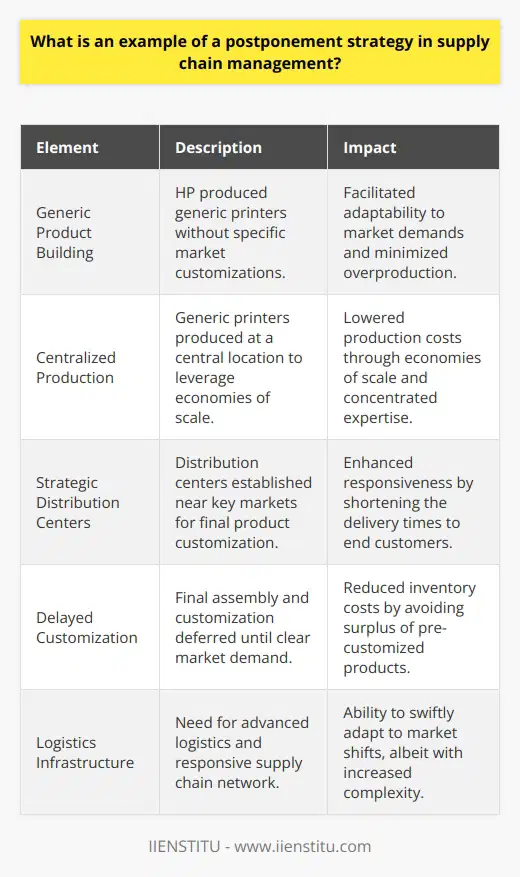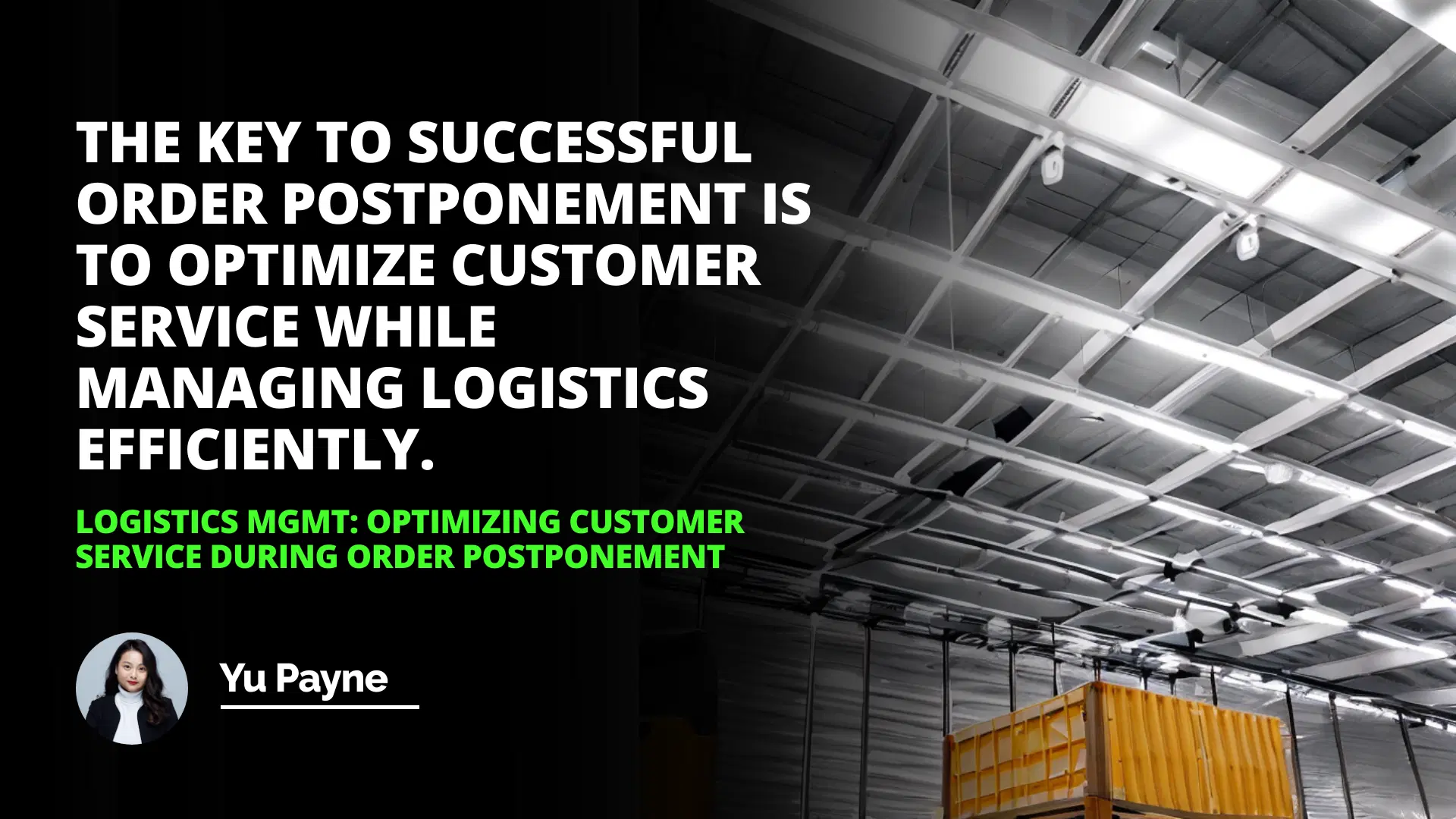
This article has explored the challenges of order postponement, the benefits of logistics management in optimizing customer service, and provided examples of logistics management solutions. By managing the supply chain, tracking orders, and inventory, businesses can ensure that orders are delivered on time and that customer expectations are met.
Related Course: Logistics Certification Courses
Introduction
Challenges of Order Postponement
Benefits of Logistics Mgmt in Optimizing Customer Service
Examples of Logistics Mgmt Solutions
Conclusion
Introduction: Customer service is a critical component of the logistics supply chain. Businesses must ensure that customer service is delivered to the highest standard and that the logistics supply chain is managed efficiently and effectively. To do this, companies must be able to manage their order postponement and logistics management solutions. This article will explore the challenges of order postponement, the benefits of logistics management in optimizing customer service, and provide examples of logistics management solutions.
Challenges of Order Postponement
Order postponement can present several challenges for businesses. Firstly, there is the challenge of managing the customer's expectations. Customers may have certain expectations about when their order will be delivered, and companies must be able to meet these expectations. Furthermore, businesses must be able to manage the customer's changing requirements. For example, if the customer requires an entire order or part thereof to be postponed or executed in detail, then businesses must be able to manage this process.
Another challenge of order postponement is managing the supply chain. If an order is postponed, then this can have a knock-on effect on the supply chain. Therefore, businesses must be able to manage the supply chain to ensure that the order is delivered on time and that the customer is not inconvenienced.
Benefits of Logistics Management in Optimizing Customer Service
Logistics management can help businesses to optimize customer service by ensuring that orders are delivered on time, and that customer expectations are met. Logistics management can help to manage the supply chain and ensure that orders are delivered on time and that the customer is not inconvenienced. Furthermore, logistics management can help manage the customer's changing requirements and ensure that the customer is satisfied with their service.
Examples of Logistics Management Solutions
Businesses can use several logistics management solutions to optimize customer service. These include:
Supply chain management: This involves managing the supply chain to ensure that orders are delivered on time. This can include tracking orders, inventory, and transportation of goods.
Order tracking: This involves tracking orders from when they are placed to when they are delivered. This can help businesses to ensure that orders are delivered on time and that the customer is not inconvenienced.
Inventory management: This involves managing the inventory of goods and ensuring that they are available when needed. This can help businesses to ensure that orders are fulfilled on time and that the customer is not inconvenienced.
Conclusion: Customer service is a critical component of the logistics supply chain, and businesses must ensure that customer service is delivered to the highest standard. To do this, companies must be able to manage their order postponement and logistics management solutions. Order postponement can present several challenges for businesses, but these can be managed through the use of logistics management solutions.
Logistics management can help businesses to optimize customer service by ensuring that orders are delivered on time, and that customer expectations are met. Examples of logistics management solutions include supply chain management, order tracking, and inventory management.
The key to successful order postponement is to optimize customer service while managing logistics efficiently.
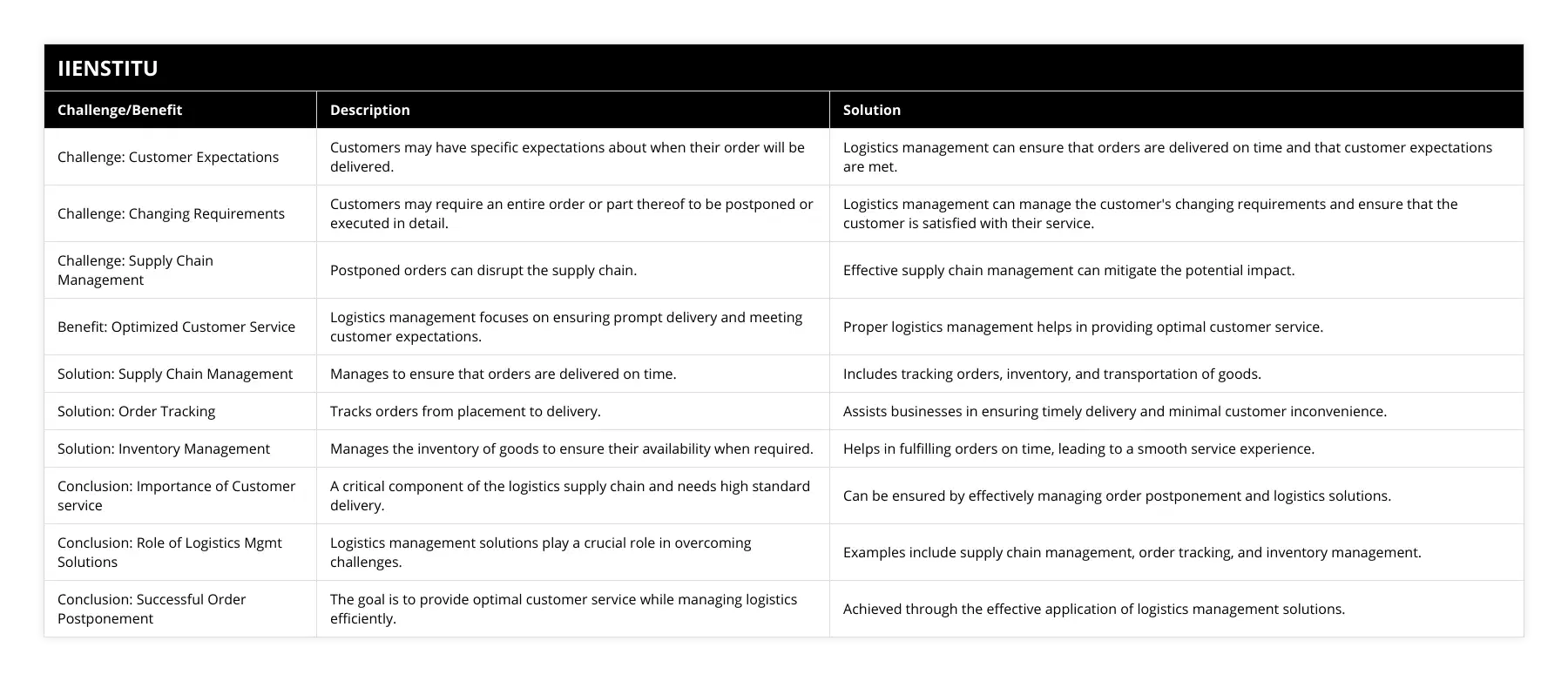
Frequently Asked Questions
What challenges are associated with order postponement?
Many businesses have adopted order postponement to reduce inventory costs and increase customer satisfaction. However, it also presents some challenges that must be managed to make it successful.
One of the significant challenges associated with order postponement is the risk of overstocking. If a business is not careful, it can end up with too much inventory in its warehouses, which will lead to additional costs associated with storage and potential spoilage. To mitigate this risk, businesses must carefully monitor their inventory levels and be prepared to adjust their order postponement strategies as needed.
Another challenge associated with order postponement is the need to adjust production schedules. Since production is being delayed until orders are placed, businesses must be prepared to adjust their production plans accordingly. This cannot be easy, as it requires managing several moving parts and ensuring that production is completed on time. Businesses must also be prepared to adjust their supply chains if needed, as suppliers may be unable to keep up with the new production schedule.
Finally, order postponement can be challenging to manage from a customer service perspective. Customers may become frustrated if their orders are delayed due to the postponement strategy, and businesses must be prepared to handle any customer complaints that may arise. Additionally, companies must ensure that their customers know the postponement strategy and the associated risks, so they can make informed decisions when placing orders.
In conclusion, order postponement can be beneficial for businesses, but it also presents some challenges. The risk of overstocking, adjustments to production and supply chain plans, and customer service issues must all be managed to make it successful. However, with the right strategies in place, businesses can use order postponement to reduce inventory costs and increase customer satisfaction.

How can logistics management help optimize customer service during order postponement?
The postponement of orders is an unavoidable part of running a business. Managing customer service during order postponement is essential to minimize customer dissatisfaction and maximize customer loyalty. Logistics management is a critical component of customer service that can help optimize customer service during order postponement.
Logistics management involves the planning, controlling, and execution of the efficient and cost-effective flow of goods and services from their point of origin to their point of consumption. This includes the management of inventory, transportation, distribution, and customer service. Businesses can optimize customer service during order postponement by focusing on logistics management.
One way to optimize customer service during order postponement is to ensure that customers are kept informed about the status of their orders. This can be achieved through various means, including automated emails, phone calls, SMS messages, or even personalized customer service. This will help to keep customers informed and minimize their frustration.
Another way to optimize customer service during order postponement is to ensure that the business can keep up with customer demand. This can be achieved through the effective use of the transportation network. Companies can ensure that customers receive their orders promptly by utilizing various transportation options, such as ground, air, and sea transportation.
Finally, businesses can optimize customer service during order postponement by employing customer relationship management (CRM) techniques. CRM techniques can help companies to identify customer needs and develop strategies to meet those needs. This includes providing personalized customer service, responding quickly to customer inquiries, and providing timely customer feedback.
Businesses can optimize customer service during order postponement by utilizing these logistics management techniques. This will help increase customer satisfaction and loyalty, leading to greater profits and a more substantial customer base.

What are some examples of logistics management solutions that can be used to improve customer service during order postponement?
Order postponement is a challenge for logistics management, as it can negatively impact customer service. To ensure customer satisfaction, logistics companies need to provide solutions that can help reduce the effects of order postponement. This article outlines some examples of logistics management solutions that can be used to improve customer service during order postponement.
One approach is to establish a clear communication strategy with customers. This involves informing customers of delays and providing regular updates throughout the postponement period. Communication should be tailored to the customer’s preferences, such as providing notifications via email, SMS, or telephone. Furthermore, the communication should include information about the cause of the delay, the expected duration, and any available alternatives or solutions.
It is also essential to prioritize customer needs. This can be done by implementing a customer service system that assigns customer priority based on their order details. For example, customers with urgent orders should be given priority over those with less urgent orders. This allows logistics companies to ensure that customers with urgent orders receive their goods promptly, even if their orders have been postponed.
Furthermore, logistics companies should also consider offering incentives for customers whose orders are postponed. This can include discounts, free shipping, and other benefits. Incentives can help to reduce customer frustration and increase customer loyalty.
It is also essential for logistics companies to invest in technologies that can improve their operations. This includes investing in automation and data analytics, which can help to reduce the time and effort required to process orders. Data analytics can also be used to identify patterns in order postponement and develop strategies to reduce the number of postponed orders. Automation can be used to streamline the fulfillment process, making it faster and more efficient.
Finally, logistics companies should also consider leveraging the power of customer feedback. This involves gathering customer feedback regarding their experience with order postponement and using it to identify areas for improvement. This can help to improve customer service, even during order postponement.
In conclusion, logistics companies must develop strategies and solutions to ensure customer service is not compromised during order postponement. This article has outlined some examples of logistics management solutions that can improve customer service during order postponement, such as establishing a clear communication strategy, prioritizing customer needs, offering incentives, investing in technologies, and leveraging customer feedback. By implementing these strategies, logistics companies can ensure customer satisfaction, even during order postponement.
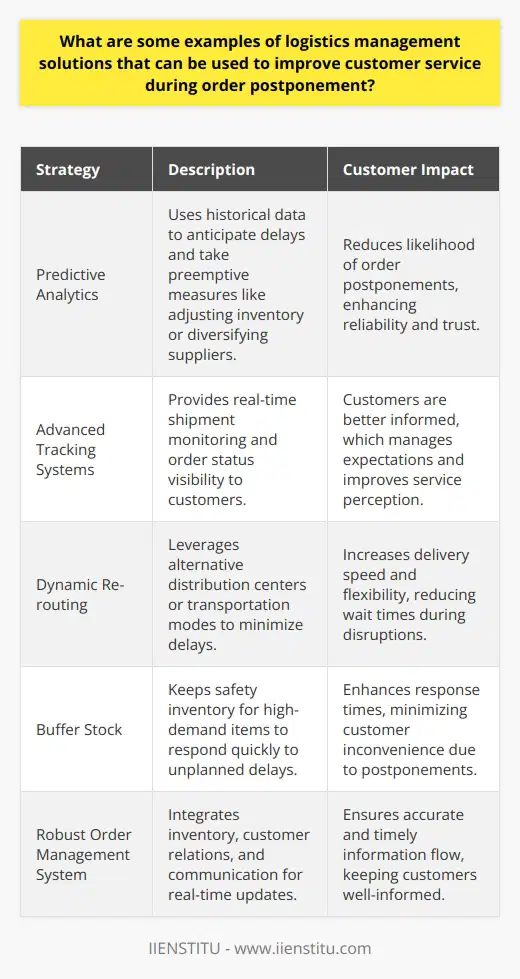
What is the principle of postponement in logistics?
The Principle of Postponement in Logistics
Overview of Postponement Strategy
The principle of postponement in logistics refers to the strategic delay of final product assembly, packaging, or completion until customer demand or a clear market pattern is confirmed. This enables companies to improve flexibility, reduce inventory costs, and ensure a more accurate response to market demand.
Postponement and Inventory Management
A key advantage of utilizing postponement strategies is the effective management of inventory. By delaying the final assembly or packaging of a product, organizations can maintain lower inventory levels and reduce the risk of overstock or obsolescence. This, in turn, allows for more efficient use of warehouse space and improved cash flow management.
Types of Postponement
There are several types of postponement strategies, including:
Form Postponement - Involves delaying the final stage of production, such as assembly or customization, until customers place orders or express specific preferences.
Time Postponement - Deals with shipping partially manufactured goods to a regional facility, where completion occurs once customer demand is confirmed.
Geographic Postponement - Occurs when products are shipped to regional warehouses in a semi-finished state, with final assembly taking place closer to the customers to reduce lead time.
Label Postponement - Refers to the delay in applying unique labeling and branding elements to products until a clear market preference emerges.
Advantages and Challenges
Implementing postponement strategies can offer numerous benefits, such as reduced inventory carrying costs, more efficient use of resources, and the ability to provide customized products. Furthermore, it can increase a company's agility and responsiveness to fluctuations in market demand, leading to improved customer service.
However, postponement also presents challenges, such as the need for a more sophisticated supply chain infrastructure and the potential for increased transportation costs. Additionally, organizations must invest in technologies and processes that facilitate the timely completion of products in line with customer expectations.
In conclusion, the principle of postponement in logistics offers substantial advantages for organizations willing to adapt their supply chain operations to better match market demand. By deploying postponement strategies, companies can enhance their flexibility, optimize inventory management, and ultimately, achieve a more customer-centric approach. Nonetheless, careful consideration of potential challenges and necessary investments in technology and infrastructure is critical to achieving the desired benefits.
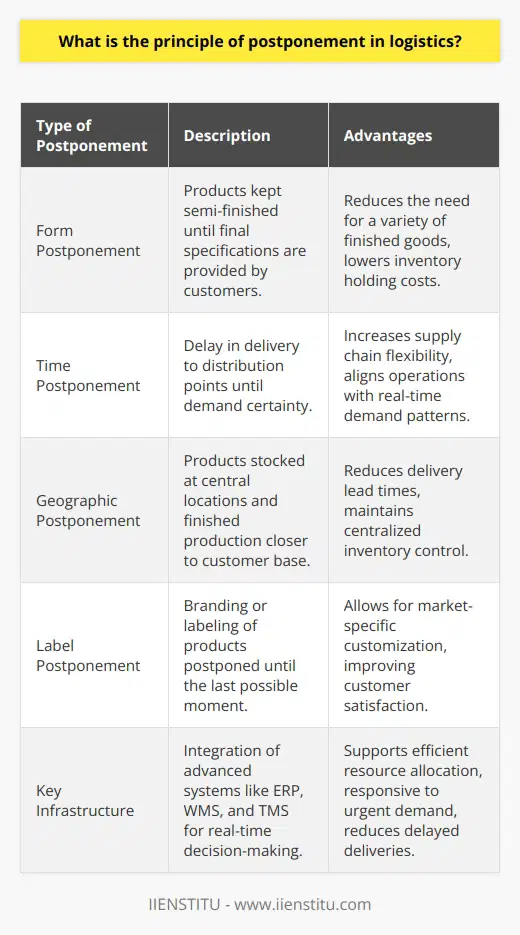
How does postponement work as a strategy in order to delivery?
Postponement Strategy and its Impact on Delivery
Defining Postponement Strategy
Postponement strategy refers to the practice of delaying the finalization and distribution of a product until receiving a customer order. This approach enables businesses to minimize inventory costs, improve customer satisfaction, and enhance supply chain efficiency by producing and delivering products based on real-time demands.
Reduced Inventory Costs
One of the primary benefits of postponement strategy is the reduction of inventory costs. By waiting to complete and ship products until customer orders arrive, companies can minimize the financial resources dedicated to holding and managing excess inventory. This approach supports better cash flow and ensures resources are only allocated to items with proven demand.
Enhanced Customer Satisfaction
Another benefit of postponement strategy is improved customer satisfaction. Tailoring production and delivery to actual customer needs allows for better responsiveness to market changes and individual preferences. By producing customized products and delivering them quickly, companies can enhance the overall buying experience, fostering customer loyalty and repeat business.
Increased Supply Chain Efficiency
The implementation of postponement strategy also contributes to increased supply chain efficiency. By delaying production and distribution, organizations can optimize their supply chain operations to better meet fluctuations in market demand. This flexibility enables supply chain partners to adapt quickly to changes and minimize potential disruptions, resulting in more streamlined and responsive processes.
Risk Mitigation
Postponement strategy can help businesses mitigate risks associated with global supply chain disruptions, product obsolescence, and demand uncertainty. When unforeseen challenges arise, a postponed approach allows organizations to react quickly and address issues more effectively. This adaptability can greatly impact a company's ability to recover from disruptions and maintain a competitive edge.
Conclusion
In summary, postponement strategy offers significant benefits for companies looking to optimize delivery processes. By waiting to finalize and ship products until customer orders arrive, businesses can reduce inventory costs, enhance customer satisfaction, and increase supply chain efficiency. Additionally, this approach helps mitigate risks associated with market fluctuations and supply chain disruptions. Adopting postponement strategy can provide a competitive advantage for organizations aiming for improved delivery performance and overall supply chain success.

What is an example of postponement strategy in supply chain management?
Example of Postponement Strategy
One notable example of a postponement strategy in supply chain management is Dell's build-to-order approach in manufacturing and distributing computers. This strategy involves delaying certain production and distribution activities until customer orders are received, enabling Dell to maintain low inventory levels and minimize costs while still providing a high degree of customization in their products.
Customization and Low Inventory
With the build-to-order approach, Dell manufactures a computer only after a customer places an order, specifying their preferred components and configurations. This tailors the product to each customer's requirements, allowing for more customization and personalization options. Unlike the traditional make-to-stock approach, in which finished products are placed in inventory and then sold, Dell's build-to-order method keeps minimal inventory on hand, reducing overhead costs such as storage, depreciation, and obsolescence.
Rapid Response to Shifting Demand
Dell's postponement strategy enables the company to react swiftly to changes in consumer demand and technological advancements. By integrating customer orders directly into manufacturing processes, Dell can prioritize production based on real-time customer needs, ensuring that the most sought-after products are produced first. This enables Dell to remain competitive in a dynamic market, as they can quickly adapt to shifting demand for different product features, components, or configurations.
Reduced Risk and Increased Efficiency
Dell's build-to-order approach also mitigates risks associated with demand forecasting and surplus inventory. By waiting to manufacture products until customer orders are placed, Dell can avoid producing excess inventory that may not sell, ultimately preventing wasted resources and potential losses. Additionally, this postponement strategy allows Dell to optimize its supply chain operations through centralized procurement, assembly, and distribution activities, leading to increased efficiency and lower costs.
In conclusion, Dell's build-to-order approach exemplifies a successful postponement strategy in supply chain management. This approach allows Dell to offer customized products to its customers while maintaining low inventory levels, rapidly responding to market fluctuations, and reducing risks associated with overproduction. Such a strategy helps Dell maintain a competitive advantage in the ever-evolving computer industry.
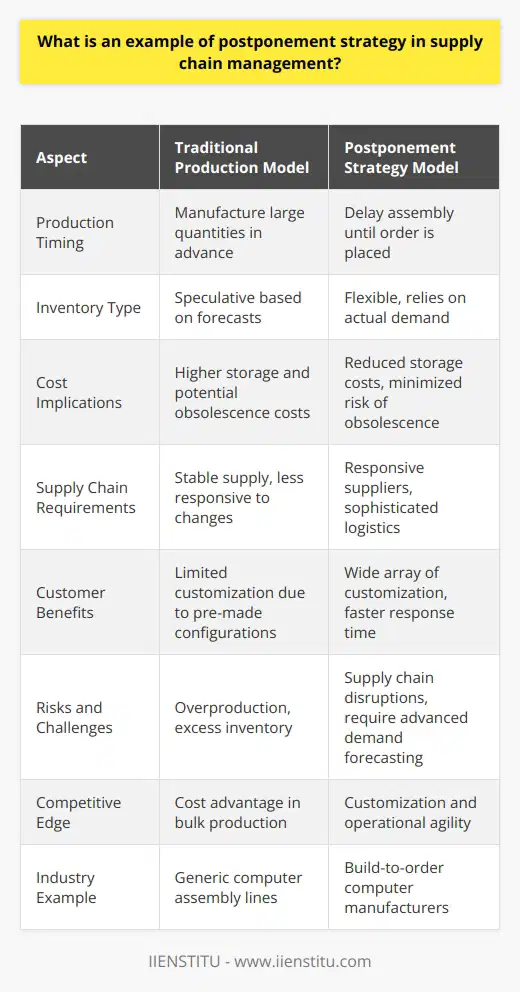
What are the 7 R's of customer service in logistics?
Understanding the 7 R's of Customer Service in Logistics
Conceptual Framework
The 7 R's of customer service in logistics encompass a set of guiding principles that aim to enhance customer satisfaction and loyalty. These principles revolve around Right product, Right quantity, Right condition, Right place, Right time, Right cost, and Right information. By adhering to these tenets, businesses can optimize their logistical operations, ensuring a competitive edge and higher revenues.
Right Product
Selecting the right product for the customer is crucial in maintaining sound logistics. Understanding the customer's specific needs and providing suitable products or services can help forge strong business relationships and foster customer loyalty.
Right Quantity
Fulfilling the right quantity entails delivering the exact amount of products requested by the customer. This prevents overstocking or understocking issues, ultimately enhancing the efficiency of the logistical process and meeting customer expectations.
Right Condition
Ensuring that products reach customers in the right condition is an essential aspect of effective logistics. Damaged, defective, or incorrectly packaged products can lead to dissatisfaction, resulting in lost sales and diminished reputation.
Right Place
The right place principle involves delivering products to the correct destination, as specified by the customer. Accurate and efficient deliveries enhance customer satisfaction, ultimately fostering trust and loyalty.
Right Time
Timely deliveries are paramount in building positive customer experiences. Adhering to agreed-upon delivery times demonstrates reliability and professionalism, strengthening the overall business relationship.
Right Cost
Offering competitive pricing while maintaining quality standards is vital in logistics. Balancing costs to align with customer expectations and industry standards can optimize logistics operations and secure customer loyalty.
Right Information
Providing accurate information about products, delivery times, and other relevant details is essential for building trust with customers and projecting transparency. Effective communication fosters a better understanding of customer needs, which in turn can contribute to streamlining logistics operations.
In conclusion, the 7 R's of customer service in logistics serve as a comprehensive framework for enhancing customer satisfaction and cultivating loyalty. By adhering to these principles, businesses can thrive in a competitive market and effectively address customer needs, thus guaranteeing a prosperous logistics operation.
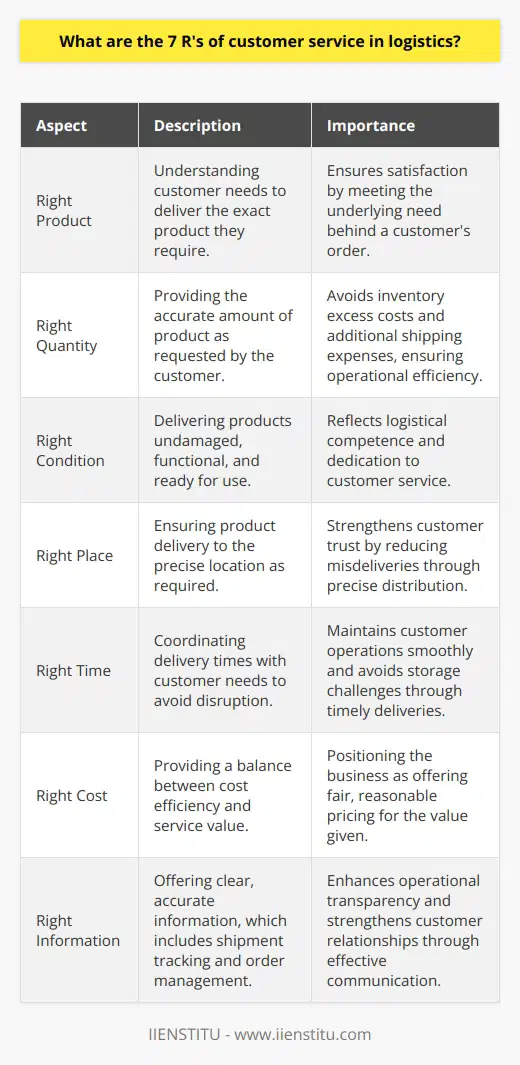
How does postponement strategy help reduce inventory costs and improve responsiveness in supply chain management?
Postponement Strategy and Inventory Costs
The postponement strategy is a crucial method in supply chain management, as it helps reduce inventory costs and improve responsiveness by delaying product differentiation until customer orders arrive. This approach allows companies to maintain a lower inventory level as undifferentiated products require less storage space and reduce the risks associated with excess or obsolete inventory.
Enhancing Responsiveness through Postponement
Furthermore, the postponement strategy enhances supply chain responsiveness by allowing companies to remain agile and quickly respond to changing customer preferences and market trends. By delaying product differentiation, firms can more easily adapt their production process to new information received from customers or suppliers. Consequently, this increased flexibility results in greater customer satisfaction and a more efficient supply chain.
Reducing Inventory Costs
The application of postponement strategy significantly reduces inventory carrying expenses, as fewer finished products need to be stored. In addition, the reduction in inventory levels leads to lower warehousing and handling costs, which further contribute to overall cost savings in supply chain management. Furthermore, companies can avoid excessive inventory write-downs and markdowns, as they adjust their production levels in line with actual demand patterns.
Promoting Collaborative Relationships
Lastly, the postponement strategy fosters a collaborative environment between supply chain partners, as companies rely on real-time information sharing to synchronize their operations efficiently. Improved communication and information flow between partners enhance coordination, leading to more precise demand forecasting and inventory planning. This collaborative approach results in greater operational efficiency and a shared focus on customer satisfaction.
In conclusion, the postponement strategy plays a vital role in reducing inventory costs and improving responsiveness in supply chain management. By delaying product differentiation and promoting collaborative relationships among supply chain partners, companies can achieve greater operational efficiency and customer satisfaction, thus improving their overall competitiveness in the market.

Can you explain the role of information technology in implementing postponement strategies in a global supply chain context?
Role of IT in Postponement Strategies
Information Technology (IT) plays a crucial role in implementing postponement strategies in global supply chain contexts, primarily by enabling flexibility, visibility, and accurate forecasting of demands. In recent years, there has been increasing interest in adopting advanced IT systems to adapt to evolving customer expectations and mitigate supply chain risks.
Enhancing Flexibility
One key aspect of IT in postponement strategies is its ability to enhance the flexibility and responsiveness of supply chains. This can be achieved through robust IT systems that facilitate efficient communication and data sharing among different stakeholders. These systems allow organizations to respond quickly to changes in market conditions by providing real-time information on inventory levels, customer orders, and production statuses. As a result, businesses can align their supply chain activities with actual customer demands, thereby minimizing surplus inventory and improving cost efficiency.
Improving Visibility
Moreover, IT plays a significant role in improving visibility across supply chains. This can be accomplished through the implementation of advanced information systems that collect, integrate, and analyze data from various sources, such as suppliers, manufacturers, and distribution centers. This comprehensive visibility enables organizations to gain a clear understanding of their global supply chain performance, identify potential bottlenecks, and take corrective actions, ensuring the seamless execution of postponement strategies.
Forecasting Customer Demand
Accurate demand forecasting is vital for the successful implementation of postponement strategies. IT systems can assist in this endeavor by analyzing and processing large amounts of historical sales data and employing advanced analytical techniques to predict future demand patterns. Furthermore, machine learning algorithms and artificial intelligence can be used to continuously refine these predictions, enabling organizations to make better-informed decisions about resource allocation, procurement, and production planning.
Facilitating Collaboration
Finally, IT fosters effective collaboration among different supply chain stakeholders by providing a platform for sharing information, resources, and knowledge. With proper collaboration, supply chain partners can jointly devise and implement postponement strategies that maximize operational efficiency and deliver value to the end customer. Additionally, IT-enabled collaboration tools can help reduce information asymmetry and facilitate the seamless integration of supply chain activities, ultimately contributing to the success of postponement strategies in the global supply chain context.
In conclusion, IT plays a pivotal role in implementing postponement strategies in global supply chains by fostering flexibility, enhancing visibility, facilitating accurate demand forecasting, and promoting collaboration among stakeholders. Implementing advanced IT solutions in these areas can significantly improve the adoption and effectiveness of postponement strategies, ultimately benefiting businesses in terms of cost efficiency, customer satisfaction, and overall supply chain performance.
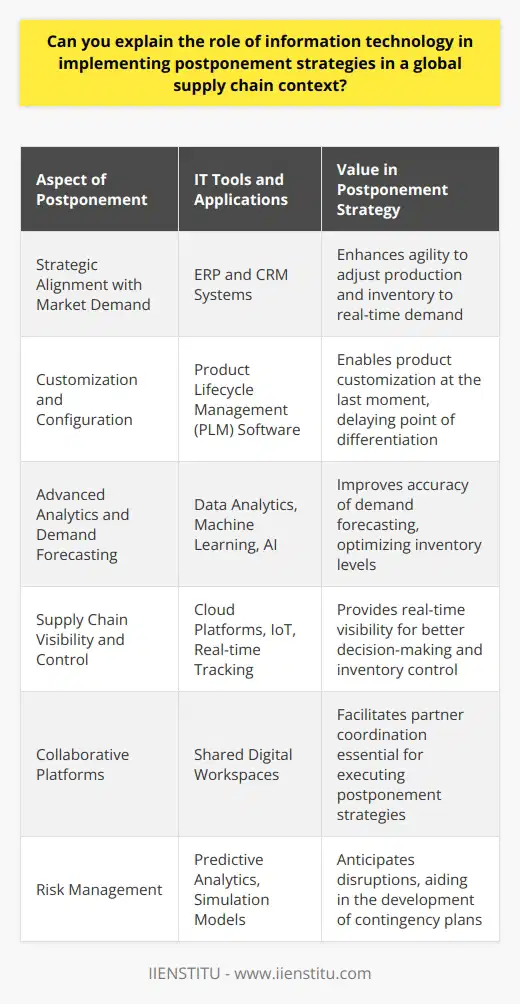
What is the principle of postponement in logistics?
Understanding the Principle of Postponement
The principle of postponement in logistics refers to a strategic approach in supply chain management that involves delaying certain processes or activities until customer demand information is known. This enables organizations to have better flexibility and responsiveness in meeting customer requirements.
Reducing Risks in Inventory Management
For instance, a manufacturing firm might delay the final assembly or customization of a product. This way, it can better align the final output with market demand, thus reducing the risk of carrying excess inventory or stock-outs. As a result, companies can minimize their investment in working capital while offering a wider array of product options to the market.
Increasing Supply Chain Flexibility
Postponement strategies impart greater flexibility to the supply chain, allowing organizations to adapt to shifting market conditions more efficiently. By waiting for precise customer demands, manufacturers can better allocate their resources, thereby reducing any inefficiencies that may arise from producing items that lack market demand.
Optimizing Transportation and Storage
In addition to inventory management, postponement strategies also benefit transportation and storage aspects of a supply chain. Delaying operations such as packaging and transportation till accurate demand information is available allows companies to consolidate shipments and optimize their transportation network. These actions lead to reduced logistics costs and improved transportation efficiency.
Enhancing Customer Satisfaction
Finally, the principle of postponement fosters enhanced customer satisfaction. By gearing production and distribution activities to the specific requirements of customers, organizations can better meet customer expectations, leading to better customer engagement and loyalty. This alignment with customer needs is a vital aspect of competing in today's complex and demanding business environment.
In summary, the principle of postponement in logistics constitutes a significant way for organizations to enhance their supply chain efficiency, reduce inventory and logistical costs, and improve overall customer satisfaction. Embracing such strategies allows businesses to remain competitive and succeed in today's fast-paced, ever-evolving marketplace.

How does postponement work as a strategy in order to delivery?
Postponement as a Strategy
Postponement as a strategy involves delaying certain activities in the supply chain until the final products are closer to the point of delivery. This approach can result in significant cost savings, improved customer satisfaction, and better inventory management.
Benefits of Postponement
By employing postponement strategies, companies can reduce the complexity of coordinating their supply chain. As a result, they can react faster to changes in demand patterns, reducing the likelihood of stockouts or overstock situations. By delaying specific processes or decisions until customer orders are received, businesses can better match the supply of goods to the actual demand.
Reducing Inventory Costs
One significant advantage of postponement is the reduction in inventory costs. By delaying the final assembly or customization of products until actual orders are received, a company can maintain lower inventory levels. This can lead to reduced warehousing costs, decreased risk of obsolescence, and improved cash flow.
Customization and Responsiveness
Postponement also allows for greater product customization and customer responsiveness. By delaying certain activities until customer orders are received, companies can tailor their products to individual customer needs. This personalized approach can result in higher customer satisfaction and increased brand loyalty.
Implementing Postponement
To successfully implement postponement in the supply chain, companies must carefully assess which activities can be delayed without compromising product quality or delivery times. Moreover, these processes must be easily adaptable, ensuring that companies can make changes quickly and efficiently in response to customer demand.
In conclusion, postponement works as a strategy in order to delivery by promoting cost savings, improved customer satisfaction, and better inventory management. By delaying specific processes or decisions until customer orders are received, companies can more effectively match the supply of goods to actual demand, ultimately leading to increased efficiency and success in a competitive market.

What is an example of a postponement strategy in supply chain management?
Postponement Strategy: Definition and Purpose
A postponement strategy in supply chain management refers to intentionally delaying certain activities or processes until a firm receives a specific customer demand or requirement. This approach aims to reduce inventory holding costs, enhance flexibility and differentiation, and improve customer responsiveness.
Example: Dell's Made-to-Order Strategy
One prominent example of a postponement strategy is Dell's made-to-order approach to producing and distributing personal computers. Dell's supply chain management relies on customization and integrating consumer preferences into the manufacturing process. This strategy allows Dell to avoid stockpiling inventories and instead produce computers based on specific customer needs.
Key Components of the Made-to-Order Strategy
The made-to-order strategy comprises several essential components that enable a business like Dell to postpone certain activities or processes in the supply chain. These components include:
Customer Collaboration: Dell engages with customers in the early stages of the supply chain, gathering essential information and specifications for a customized product.
Supplier Integration: Close relationships and communication channels with suppliers enable Dell to procure specific components efficiently and promptly, based on actual customer orders.
JIT (Just-in-Time) Manufacturing: Dell's manufacturing system allows it to produce and assemble computer components swiftly after receiving an order, reducing warehouse storage costs and potential product obsolescence.
Direct Distribution: Dell has eliminated intermediaries such as retailers and distributors by shipping its products directly to customers.
Benefits and Challenges of Postponement Strategy
There are several benefits to the made-to-order postponement strategy. By waiting for a customer order before initiating production or shipment, Dell significantly reduces inventory holding costs and minimizes investment in obsolete or slow-moving products. The strategy also enables Dell to better match supply with demand, increasing customer satisfaction and reducing lead times.
However, the postponement strategy also presents challenges. Close collaboration with suppliers and strict controls over component availability are critical to ensure a swift and efficient manufacturing process. Additionally, while Dell experiences lower inventory costs, it must balance these savings against investments in advanced manufacturing systems and potential increases in transportation costs due to expedited shipments.
In conclusion, Dell's made-to-order approach serves as a prime example of a postponement strategy in supply chain management. Implementing this strategy allows Dell to meet customers' specific needs, reduce inventory costs, and improve overall supply chain resilience.
